Hoxton House
Hoxton Street, Hoxton, N1 6LR
Medical
dates:
Medical
character:
Mental (Licensed House)
In 1695 Hoxton House, a large
brick building, opened as a private lunatic asylum in an area which was
rapidly changing; many of the estates were being broken up and their
large houses converted into madhouses.
In 1715 the business was bought by the Miles family.
The asylum took both private patients and pauper lunatics (especially from the City of London). The latter resided in closed wards. Insane inmates from Newgate and other prisons were also admitted, until they recovered their sanity or died.
For physical illness, private patients could be cared for by their own family doctors, while paupers were treated by various parish doctors. A house surgeon and an apothecary visited daily.
In 1756 two large houses in Hoxton Street were purchased as additional accommodation.
Further expansion into the surrounding streets took place in 1784, after which it became the largest asylum in Hoxton, with 2 acres of grounds between Pitfield Street and Kingsland Road for use by the private patients for exercise.
From 1792 the asylum received officers and men who had become insane while serving in the Royal Navy. Ostensibly, payment for their care was from the Chatham Chest funds, but was underwritten by the State. A naval surgeon visited and treated these patients, and an Inspector of Naval Hospitals inspected the premises at intervals.
In the first year, some 18 naval patients (2 officers and 16 seamen) had been received, but the numbers gradually increased by 10 to 20 new patients each year. By 1805, following the Battle of Trafalgar, the asylum contained some 80 naval patients (10 officers and 70 men).
By the early 19th century, nearly all London's private madhouses were in Hoxton and the area became synonymous with lunacy, mainly from unwanted notoriety.
In 1808 it was reported that patients in the asylum were poorly clothed, and even went about naked in the yard, covered only with a piece of blanket.
The asylum was enlarged again in 1814. It accepted three classes of patients: pauper, government (naval) and private. Of the 150 naval patients, 17 were officers and 133 seamen. The weekly charge for a naval officer was 24 shillings and 6 pence (£1.23) and, for a seaman 15 shillings and 6 pence (78p) for the first 28 days, then 10s 6d (53p) thereafter. The charge for a pauper inmate was also 10s 6d (53p).
In 1815 the asylum contained 484 inmates, of whom 16 were naval officers, 136 seamen or marines and 332 non-government patients.
At this time the asylum was owned by Sir Jonathan Miles, an alderman of the City of London. Conditions within had seriously deteriorated, with deaths from neglect and harsh treatment covered up by bribery. The Inspectors of Naval Hospitals called attention to the poor state of the naval inmates, as indeed did certain Guardians of the Poor and several philanthropists, who were deeply concerned about the treatment of pauper lunatics.
Inspectors were discouraged from entering, but those who did manage to get past the doorkeeper found conditions abominable. Dr James Veitch, a naval surgeon, found the floors "soaked with urine", while the bedrooms were "close, crowded and unventilated". The incontinent were roomed with the continent. Patients were forced to share narrow beds and some were chained to benches. There was insufficient bed linen and patients had to make do with loose straw. A sick man lay in a room in which "the smell and nature of the apartment was utterly unfit for a human being to reside in, in any shape". There were no provisions for the physically ill, who remained in the wards with the mentally ill, and no attempt at treatment for any kind of illness. Everywhere in the asylum was "all chaos and confusion". There were no tables and patients had to eat standing up; no cutlery was provided so they had to eat with their hands. The exercise yards were cramped, with no shelter, and surrounded by a high wall.
Staff levels were low, in a ratio of 1:20. In one room, measuring 19' 5" by 14' (5.1 metres by 4.0 metres) one keeper was expected to help dress, wash and shave 20 patients.
Another naval surgeon, Dr John Weir, called for a special hospital for naval lunatics to be built.
In 1815 a Select Committee of the House of Commons began an investigation into conditions within lunatic asylums. The reports revealed the horrific conditions inside Hoxton House and the harsh treatment of seamen, some of whom had served under Nelson. Violent patients were not separated from quiet ones, and 6 beds had 2 patients in each. Some patients were unnecessarily kept handcuffed to beds overnight or benches during the day. Dangerous patients were handcuffed and their legs chained, with a chain (bazil) linking the handcuffs to the leg irons.
The findings increased public awareness of the treatment of lunatics and led to demands for improvement and reform. However, despite this, little changed. The Committee censured Sir Jonathan Miles, but he remained in business.
Hoxton House remained the Naval Lunatic Asylum until 1818, when part of the Royal Hospital Haslar in Gosport was given over to accommodate insane officers and men.
In 1819 the asylum housed 348 patients.
A second Select Committee was set up in 1827 to again thoroughly investigate the scandalous maltreatment of lunatic patients. Following the Committee's report, the Lunacy Commission was established to monitor and regulate the care and treatment provided in private madhouses. The Madhouses Act, 1928 aimed to strengthen safeguards against a person being illegally detained in a madhouse, by requiring two medical certificates and authorisation by a relative before a patient could be admitted (paupers required only one doctor and a magistrate to commit them).
In 1844 an inspection by the Lunacy Commissioners found the internal arrangements of the asylum to be inconvenient and defective. It was located in a densely crowded neighbourhood with no land on which the pauper inmates could be employed. The exercise yards were dull and confined.
The County Asylums Act, 1845, compelled local authorities in each county to build their own lunatic asylums. As these became available, pauper lunatics within private madhouses were transferred to their own county asylums.
By 1871 the asylum was licensed for 325 inmates (94 male and 231 female), but with an average number of 257 in residence. Its owner was Dr W.J. Hunt, who lived in a gentleman's property apparently separate from the asylum.
In 1885 the asylum, spread over an area of 2 acres, contained wards and dormitories, attendants' dwellings, 3 cottages, a dining room, a theatre, a lodge. Both sexes were admitted, both as private fee-paying patients or as paupers (especially from the City of London).
In 1898 the asylum contained 280 private and pauper patients of both sexes.
It closed in 1902.
In 1715 the business was bought by the Miles family.
The asylum took both private patients and pauper lunatics (especially from the City of London). The latter resided in closed wards. Insane inmates from Newgate and other prisons were also admitted, until they recovered their sanity or died.
For physical illness, private patients could be cared for by their own family doctors, while paupers were treated by various parish doctors. A house surgeon and an apothecary visited daily.
In 1756 two large houses in Hoxton Street were purchased as additional accommodation.
Further expansion into the surrounding streets took place in 1784, after which it became the largest asylum in Hoxton, with 2 acres of grounds between Pitfield Street and Kingsland Road for use by the private patients for exercise.
From 1792 the asylum received officers and men who had become insane while serving in the Royal Navy. Ostensibly, payment for their care was from the Chatham Chest funds, but was underwritten by the State. A naval surgeon visited and treated these patients, and an Inspector of Naval Hospitals inspected the premises at intervals.
In the first year, some 18 naval patients (2 officers and 16 seamen) had been received, but the numbers gradually increased by 10 to 20 new patients each year. By 1805, following the Battle of Trafalgar, the asylum contained some 80 naval patients (10 officers and 70 men).
By the early 19th century, nearly all London's private madhouses were in Hoxton and the area became synonymous with lunacy, mainly from unwanted notoriety.
In 1808 it was reported that patients in the asylum were poorly clothed, and even went about naked in the yard, covered only with a piece of blanket.
The asylum was enlarged again in 1814. It accepted three classes of patients: pauper, government (naval) and private. Of the 150 naval patients, 17 were officers and 133 seamen. The weekly charge for a naval officer was 24 shillings and 6 pence (£1.23) and, for a seaman 15 shillings and 6 pence (78p) for the first 28 days, then 10s 6d (53p) thereafter. The charge for a pauper inmate was also 10s 6d (53p).
In 1815 the asylum contained 484 inmates, of whom 16 were naval officers, 136 seamen or marines and 332 non-government patients.
At this time the asylum was owned by Sir Jonathan Miles, an alderman of the City of London. Conditions within had seriously deteriorated, with deaths from neglect and harsh treatment covered up by bribery. The Inspectors of Naval Hospitals called attention to the poor state of the naval inmates, as indeed did certain Guardians of the Poor and several philanthropists, who were deeply concerned about the treatment of pauper lunatics.
Inspectors were discouraged from entering, but those who did manage to get past the doorkeeper found conditions abominable. Dr James Veitch, a naval surgeon, found the floors "soaked with urine", while the bedrooms were "close, crowded and unventilated". The incontinent were roomed with the continent. Patients were forced to share narrow beds and some were chained to benches. There was insufficient bed linen and patients had to make do with loose straw. A sick man lay in a room in which "the smell and nature of the apartment was utterly unfit for a human being to reside in, in any shape". There were no provisions for the physically ill, who remained in the wards with the mentally ill, and no attempt at treatment for any kind of illness. Everywhere in the asylum was "all chaos and confusion". There were no tables and patients had to eat standing up; no cutlery was provided so they had to eat with their hands. The exercise yards were cramped, with no shelter, and surrounded by a high wall.
Staff levels were low, in a ratio of 1:20. In one room, measuring 19' 5" by 14' (5.1 metres by 4.0 metres) one keeper was expected to help dress, wash and shave 20 patients.
Another naval surgeon, Dr John Weir, called for a special hospital for naval lunatics to be built.
In 1815 a Select Committee of the House of Commons began an investigation into conditions within lunatic asylums. The reports revealed the horrific conditions inside Hoxton House and the harsh treatment of seamen, some of whom had served under Nelson. Violent patients were not separated from quiet ones, and 6 beds had 2 patients in each. Some patients were unnecessarily kept handcuffed to beds overnight or benches during the day. Dangerous patients were handcuffed and their legs chained, with a chain (bazil) linking the handcuffs to the leg irons.
The findings increased public awareness of the treatment of lunatics and led to demands for improvement and reform. However, despite this, little changed. The Committee censured Sir Jonathan Miles, but he remained in business.
Hoxton House remained the Naval Lunatic Asylum until 1818, when part of the Royal Hospital Haslar in Gosport was given over to accommodate insane officers and men.
In 1819 the asylum housed 348 patients.
A second Select Committee was set up in 1827 to again thoroughly investigate the scandalous maltreatment of lunatic patients. Following the Committee's report, the Lunacy Commission was established to monitor and regulate the care and treatment provided in private madhouses. The Madhouses Act, 1928 aimed to strengthen safeguards against a person being illegally detained in a madhouse, by requiring two medical certificates and authorisation by a relative before a patient could be admitted (paupers required only one doctor and a magistrate to commit them).
In 1844 an inspection by the Lunacy Commissioners found the internal arrangements of the asylum to be inconvenient and defective. It was located in a densely crowded neighbourhood with no land on which the pauper inmates could be employed. The exercise yards were dull and confined.
The County Asylums Act, 1845, compelled local authorities in each county to build their own lunatic asylums. As these became available, pauper lunatics within private madhouses were transferred to their own county asylums.
By 1871 the asylum was licensed for 325 inmates (94 male and 231 female), but with an average number of 257 in residence. Its owner was Dr W.J. Hunt, who lived in a gentleman's property apparently separate from the asylum.
In 1885 the asylum, spread over an area of 2 acres, contained wards and dormitories, attendants' dwellings, 3 cottages, a dining room, a theatre, a lodge. Both sexes were admitted, both as private fee-paying patients or as paupers (especially from the City of London).
In 1898 the asylum contained 280 private and pauper patients of both sexes.
It closed in 1902.
Present
status (August 2016)
The buildings were demolished and Hoxton House School was built on the site by the LCC in 1911. Only No. 34 Hoxton Street survives.
Hoxton Community College has replaced the School. Its main entrance is in Falkirk Street.
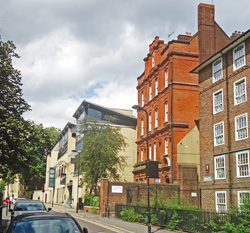
Looking from the south along Hoxton Street towards the site of the asylum. The original Hoxton House was more or less enclosed, and set back from Hoxton Street. No. 34 Hoxton Street (the red brick building) is the only surviving part.
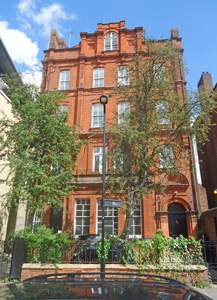
No. 34 Hoxton Street (above and below) has been converted into apartments .
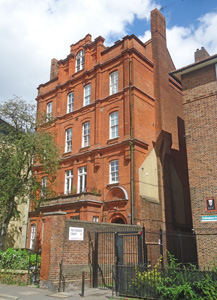
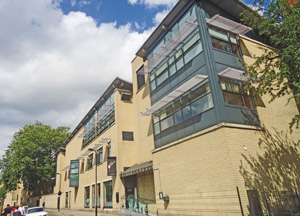
Most of the site is now part of the Hackney Community College - all enclosed (above and below).
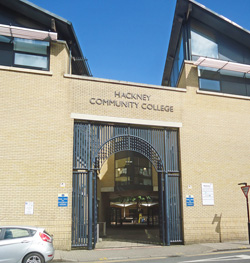
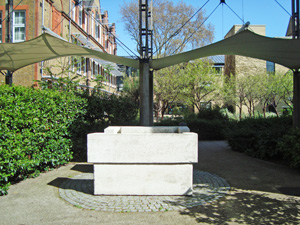
The garden within the College.
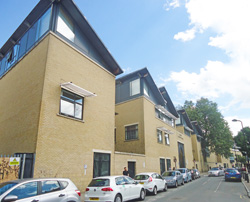
The site of the asylum along Hoxton Street from the north.
(Author unstated) 1882 Thirty-sixth Report of the Commissioners in Lunacy to the Lord Chancellor, Vol. 32. London, House of Commons.
Morris AD 1989 James Parkinson His Life and Times. Boston, Birkhauser.
Parry-Jones WL 1972 The Trade in Lunacy: a Study of Private Madhouses in England in the Eighteenth and Nineteenth Centuries. London, Routledge and Kegan Paul.
Rogers JW 1815 A statement of the cruelties, abuses and frauds pracised in Mad-Houses. In: Report from the Committee of the House of Commons on Madhouses in England. London, House of Commons.
Sharpe JB 1815 Report, Together with the Minutes of Evidence, and an Appendix of Papers from the Committee Appointed to Consider of Provision Being Made for the Better Regulation of Madhouses in England. London, House of Commons.
Watson K 2005 The Devil Kissed Her: The Story of Mary Lamb. London, Bloomsbury.
Winslow LS 1874 Manual of Lunacy. Republished by Cambridge University Press in 2014.
http://en.wikipedia.org
http://hansard.millbanksystems.com (1)
http://hansard.millbanksystems.com (2)
http://studymore.org.uk (1)
http://studymore.org.uk (2)
http://studymore.org.uk (3)
http://the-mastiff-by-marcel-wynants.com
https://printsandephermera.com
www.british-history.ac.uk
www.britishnavalhistory.com
www.genguide.co.uk
www.london-footprints.co.uk
www.orleyandbrass.com
www.themacbeth.co.uk
www.worldmastiffforum.com
Return to alphabetical list
Return to home page